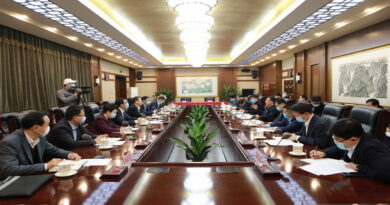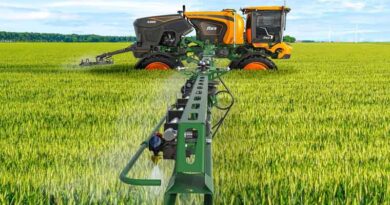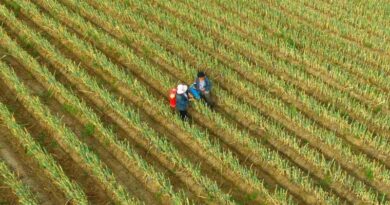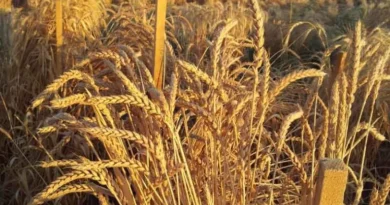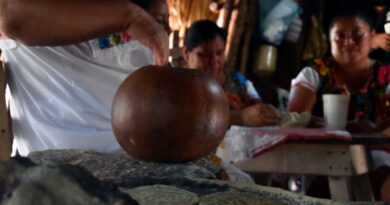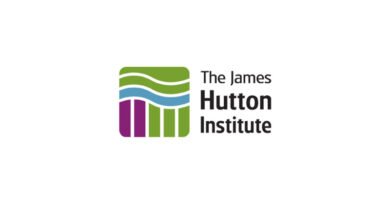China: Optimize sea use for aquaculture and build a “blue granary”
01 January 2024, China: the General Office of the Ministry of Natural Resources and the General Office of the Ministry of Agriculture and Rural Affairs jointly issued the “Notice on Optimizing the Management of Sea Breeding for Breeding” (hereinafter referred to as the “Notice”), proposing a series of policies and measures for optimizing the management of sea use for breeding. In order to facilitate all sectors of society to accurately understand and grasp the main spirit of the “Notice”, relevant persons in charge of the Sea Area and Island Management Department of the Ministry of Natural Resources and the Fisheries and Fisheries Administration Bureau of the Ministry of Agriculture and Rural Affairs conducted policy interpretations.
Question: What is the significance of the issuance of the “Notice” to the implementation of the decision-making and deployment of “asking for food from the ocean” and the construction of a “blue granary”?
Answer: The report of the 20th National Congress of the Communist Party of China proposed to establish a comprehensive food concept, build a diversified food supply system, accelerate the green transformation of development methods, and promote the conservation and intensive use of various resources. In 2023, General Secretary Xi Jinping pointed out during an inspection in Guangdong that “to ensure food security, we must establish a big food concept and ask for food from both land and the sea.” Sea farming is a traditional sea area development and utilization activity, and it is also the type of sea area use with the largest sea area in my country. According to statistics, my country’s current marine aquaculture area is 31.11 million acres. The sea for aquaculture has become an important resource factor in addition to the 1.8 billion acres of cultivated land. It requires heat and protein from the ocean and expands food supply. The “Notice” fully implements the spirit of the Party Central Committee, based on strictly observing the bottom line of resource security, optimizing the land spatial pattern, promoting green and low-carbon development, and safeguarding the rights and interests of resource assets, and proposes a series of policies and measures to optimize the management of sea farming, which is related to the national economy and people’s livelihood and Food security and ensuring the supply of marine aquaculture products are also of great significance to the economic development and social stability of coastal areas.
First, vigorously promote the conservation and intensive utilization of marine resources. Saving resources is a basic national policy of our country, and the conservation and intensive use of natural resources is an important part of accelerating the green transformation of development methods. At present, my country’s offshore waters are developed intensively, and some sea areas are utilized in an extensive and low-efficiency manner. By optimizing the management of the sea for aquaculture, scientifically determining the scale and layout of the sea for aquaculture, and encouraging the development of multi-level comprehensive aquaculture, we can make full use of the three-dimensional space of seawater and further improve the efficiency of sea resource utilization.
The second is to comprehensively promote the high-quality development of marine fisheries. As the world’s largest aquaculture country, my country’s marine aquaculture is still dominated by traditional farming methods, and ecologically healthy farming needs to be improved. By optimizing the management of sea for aquaculture and promoting ecological sea use for aquaculture, we can effectively promote the upgrading and high-quality development of mariculture, stabilize and expand the supply of mariculture products, and lay a solid foundation for the construction of a “blue granary.”
The third is to effectively strengthen the protection of the marine ecological environment. The current unstandardized development of marine aquaculture in some areas has had a certain impact on the local marine environment, and the over-exploitation of some marine aquaculture has affected the function of coastal wetlands to a certain extent. By optimizing the management of the sea for aquaculture, strictly controlling the scale of newly added sea aquaculture, and not occupying the natural coastline and ecological protection red line, clarifying the control requirements for necessary supporting facilities in the sea aquaculture area, and properly disposing of aquaculture waste, it is conducive to protection and improvement. Marine ecological environment.
The fourth is to effectively protect the legitimate rights and interests of breeding producers. The use of seawater for aquaculture involves a wide range of areas and is related to the vital interests of the masses in fishing areas. By optimizing the management of sea use for aquaculture and issuing sea area real estate registration certificates and aquaculture certificates (“two certificates”) in accordance with the law, it will play a positive role in safeguarding the rights and interests of sea area resource owners, protecting the legitimate rights and interests of various aquaculture producers, and promoting social stability in coastal areas.
Q: What are the main policy considerations behind the issuance of the Notice?
Answer: In recent years, the natural resources and agriculture and rural (fishery) departments have thoroughly implemented the decisions and arrangements of the Party Central Committee and the State Council, fully implemented the “Sea Area Use Management Law of the People’s Republic of China”, the Fisheries Law of the People’s Republic of China and other relevant laws and regulations, and compiled land and space plans. Planning and tidal flat planning for aquaculture waters, stabilizing the healthy seawater aquaculture area, and issuing “two certificates” in accordance with the law, effectively protecting the legitimate rights and interests of all types of seawater users for aquaculture. At the same time, with the development of the marine aquaculture industry, problems such as unreasonable layout of the sea for aquaculture and irregular clearance of near-shore aquaculture have existed in coastal areas to varying degrees.
The “Notice” adheres to the people-centered development idea and focuses on the primary task of high-quality development. It mainly has four policy considerations:
First, adhere to a problem-oriented approach and add new categories of management and control. There are various ways of using the sea for aquaculture and diverse business entities, so it is necessary to adopt classified control measures and clarify management requirements. For sea aquaculture that changes the natural properties of the sea area, the scale of new sea use must be strictly controlled; for commercial aquaculture use, the transfer of sea water in a market-oriented manner is encouraged; for artificial reef-based marine ranches, scientific assessment and reasonable determination of sea use must be carried out manner and scale.
The second is to adhere to laws and regulations and properly dispose of existing stocks. my country’s large-scale marine aquaculture began in the 1980s. The use of sea for aquaculture has a long history, and the specific problems are complex. Some no longer meet the existing spatial planning or ecological protection red line control requirements, and some have not gone through the sea use approval procedures in accordance with the law. They must start from the maintenance Bearing in mind the overall interests of social stability, we should adapt measures to local conditions and handle matters appropriately.
The third is to adhere to simple administration and convenience for the people and reduce the burden on fishermen. Maintaining the basic rights and interests of traditional fishermen is an important basis for ensuring people’s livelihood and social stability. Therefore, it is necessary to delineate a certain range of fishermen’s traditional breeding sea areas, further optimize the application and approval procedures for sea farming, reduce or exempt sea area use fees in accordance with the law, and effectively reduce the burden on traditional fishermen.
The fourth is to adhere to ecological priority and promote green breeding. Compared with traditional breeding methods, the ecologically healthy breeding model has more advanced facilities and equipment, more advanced breeding technology, more efficient production methods, and less impact on the marine ecological environment. It is necessary to actively encourage and promote ecological and healthy breeding models, promote the application of ecological and environmentally friendly breeding materials, improve the modernization level of breeding facilities and equipment, and promote the green and high-quality development of the aquaculture industry.
Based on the above policy considerations, the “Notice” focuses on scientifically determining the scale and layout of aquaculture seas, classifying and controlling new aquaculture seas, properly disposing of existing aquaculture seas, comprehensively regulating the approval and transfer of aquaculture seas, and actively promoting ecological aquaculture seas. and effectively strengthen the supervision of the sea for aquaculture, and propose policies and measures to optimize the management of the sea for aquaculture.
Question: In terms of optimizing and ensuring the development space of marine aquaculture, what policy measures does the “Notice” propose?
Answer: In order to ensure and optimize the development space of marine aquaculture, the “Notice” focuses on three specific measures.
The first is to scientifically determine the scale of sea use for farming. When the local natural resources (marine) authorities prepare special plans for land and space such as coastal zones, they should delineate additional breeding areas based on the planning zoning determined by the overall land and space planning, combined with the tidal flat planning of breeding waters, and scientifically determine the scale of sea use for breeding and stabilize it. Healthy seawater culture area.
The second is to actively support the use of deep-sea aquaculture. Expand deep-water far-shore areas suitable for fishing, optimize the layout of the sea for aquaculture, actively support the use of sea for deep-sea aquaculture and marine ranching, and accelerate the construction and application of deep-sea aquaculture fisheries such as gravity cages, truss-type cages, and breeding work ships.
The third is to clearly and strictly prohibit and moderately control the use of sea for breeding. The breeding area shall not be designated in military restricted areas and management areas, ports, waterways, anchorages, submarine cable pipeline protection areas and other sea areas that are expressly prohibited by law. Moderately control the scale of aquaculture use in important bays, estuaries, and coastal waters of coastal cities.
Question: “Traditional fishermen” are mentioned many times in the document. In terms of safeguarding the legitimate rights and interests of traditional fishermen, what specific measures does the “Notice” clarify?
Answer: Regarding safeguarding the legitimate rights and interests of traditional fishermen, the Notice mainly clarifies the following four policy measures.
The first is to delineate traditional breeding areas for fishermen according to local conditions. All localities should delineate a certain range of fishermen’s traditional breeding sea areas based on the status of sea area resources, the current status of sea farming and the number of fishermen to protect the livelihood of traditional fishermen. Fishermen’s traditional breeding sea areas mainly refer to the breeding seas that have been managed by rural collective economic organizations or village committees before the implementation of the Sea Area Utilization and Management Law of the People’s Republic of China.
The second is to give priority to ensuring local traditional fishermen’s use of the sea. When issuing “two certificates” in fishermen’s traditional breeding areas, priority should be given to local fishery producers so that their legitimate rights and interests are protected by law. If the sea area use rights of fishermen’s traditional breeding sea areas are determined to the village’s collective economic organization or village committee, the relationship between national sea area ownership, village collective sea area use rights, and fishermen’s individual contract management rights must be properly handled.
The third is to effectively reduce the burden on fishermen. It is necessary to optimize the application and approval procedures for sea use for aquaculture, comprehensively improve the efficiency of administrative approval, reduce or exempt sea area use fees in accordance with the law, and effectively reduce the burden on traditional fishermen. The entire sea area use demonstration can be carried out for the sea area used for breeding and the sea area used for fishermen’s traditional breeding sea areas. When units and individuals apply for sea use, they do not need to conduct sea area use demonstration, which effectively reduces the steps and costs of fishermen’s sea use application.
Fourth, necessary facilities are allowed to be built in the sea-enclosed breeding area. The construction of fishing gear storage places and care facilities necessary for aquaculture production, fish harvesting and temporary storage platforms, sewage treatment facilities, production access roads with a width of less than 6 meters, simple breeding greenhouses, pond slope protection and seawall reinforcement are allowed in the sea area for aquaculture production. Projects and other supporting facilities; in addition, no other supporting facilities are allowed to be added, and breeding ponds are not allowed to be filled or hardened. Before constructing and expanding the above-mentioned supporting facilities necessary for aquaculture production, a report must be made to the natural resources (ocean) authority at the same level as the original approval authority.
Question: The “Notice” requires the safe disposal of existing seas used for aquaculture. What provisions are made for the scope of clearance and disposal principles of existing seas used for aquaculture?
Answer: In order to maintain the order of sea area management and protect the marine ecological environment, the two types of existing sea areas used for aquaculture must be cleared in an orderly manner. First, it is located within the ecological protection red line and does not comply with the control policies of the “Notice of the Ministry of Natural Resources, the Ministry of Ecology and Environment, and the National Forestry and Grassland Administration on Strengthening the Management of Ecological Protection Red Lines (Trial)” (Natural Zifa [2022] No. 42) The second is the sea for breeding that does not have legal and compliant real estate rights certificates or certificates of rights, breeding certificates, etc. outside the ecological protection red line and does not comply with special plans such as the overall land space planning, coastal zone planning, and tidal flat planning for breeding waters. Within the ecological protection red line, aquaculture activities that comply with control policies are allowed without expanding the scale of existing aquaculture. Considering that artificial reefs play a certain role in improving the marine ecological environment, and the recovery of artificial reefs that have been placed is difficult and costly, and removal will cause damage to marine ecological functions, marine ranches that have placed artificial reefs are not within the scope of removal. Inside.
Existing sea disposal for aquaculture should be based on the following principles: First, in accordance with laws and regulations. Coastal areas must be disposed of in accordance with the “Sea Area Use Management Law of the People’s Republic of China”, “Fisheries Law of the People’s Republic of China” and related regulations. Any illegal use of sea for aquaculture must be investigated and dealt with in accordance with the law. The withdrawal will bring serious consequences to legal and compliant aquaculture producers. Economic losses must be compensated in accordance with the law. The second is to respect history. The use of sea for aquaculture is a long-standing traditional sea use activity, which involves the basic livelihood and vital interests of the majority of fishermen. Therefore, historical factors must be fully considered in the disposal work, facts and policies should be combined, and relevant issues should be handled objectively and fairly, in line with the conditions for the “two certificates” should be reissued as soon as possible. The third is to be steady and orderly. All coastal areas must adhere to the people’s position, enhance their awareness of the overall situation, strengthen their responsibility, and gradually advance the disposal work, and must not adopt “campaign-style” or “one-size-fits-all” measures. If social stability risks are involved, a social stability risk assessment should be carried out.
Also Read: Brazil: New Pesticide Law in force, potential to reach 4400 registrations
(For Latest Agriculture News & Updates, follow Krishak Jagat on Google News)



